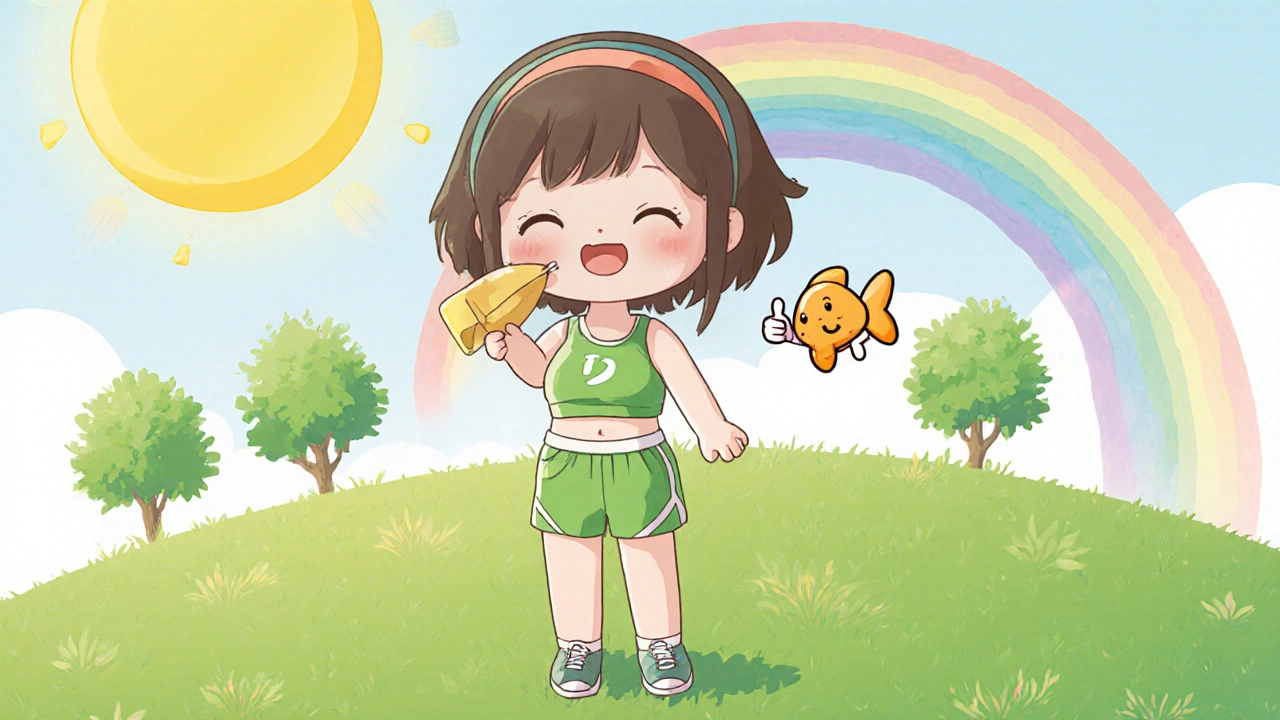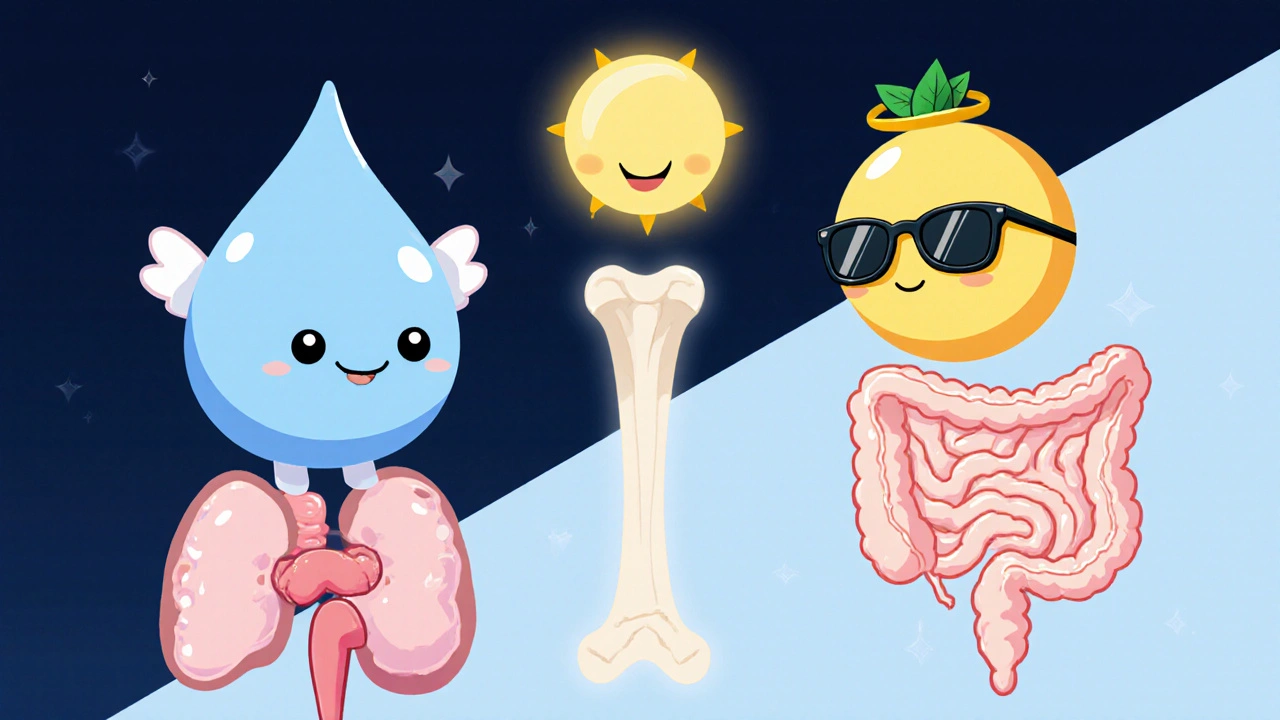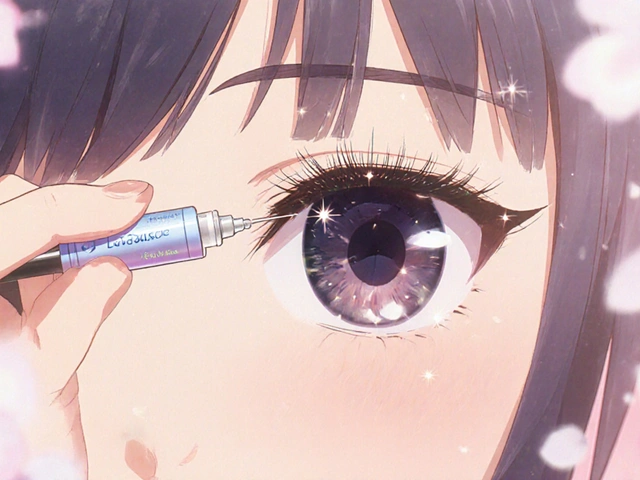Calcium Balance Estimator
How Your Lifestyle Affects Calcium Balance
Calcium balance is determined by how much calcium you take in versus how much your body uses and excretes. This calculator estimates if you're in positive balance (building bone), negative balance (losing bone), or neutral balance (optimal) based on your inputs.
Key factors: Calcium intake, vitamin D levels, sun exposure, and physical activity all influence calcium regulation and bone health.
Key Takeaways
- Calcitonin lowers blood calcium by acting on bone and kidneys.
- Vitamin D raises calcium absorption from the gut and supports bone mineralisation.
- The two hormones form a feedback loop that keeps calcium levels stable.
- Disruptions can lead to hyper‑ or hypocalcaemia, osteoporosis, or kidney stones.
- Balanced diet, sensible sun exposure, and regular exercise help both systems work optimally.
Ever wonder why a tiny hormone from the thyroid can influence the strength of your bones? Or why a vitamin you get from the sun is called a hormone? The answer lies in the intricate dance between calcitonin and vitamin D. Understanding how they interact gives you a practical edge on bone health, calcium balance, and preventing common disorders.
What is Calcitonin?
Calcitonin is a peptide hormone secreted by the thyroid’s C‑cells (also called parafollicular cells). Its primary job is to lower blood calcium levels by inhibiting bone‑resorbing cells and increasing calcium excretion in the kidneys. Discovered in the 1960s, it’s often called the “calcium‑lowering hormone.” Humans produce only modest amounts, but the effect is quick and precise.
What is Vitamin D?
Vitamin D refers to a group of fat‑soluble secosteroids, the most important forms being D2 (ergocalciferol) and D3 (cholecalciferol). In the body, they are converted first in the liver to 25‑hydroxyvitamin D, then in the kidney to the active hormone 1,25‑dihydroxyvitamin D, also known as Calcitriol. Calcitriol is the true endocrine agent that boosts calcium absorption from the intestine and has wide‑reaching effects on bone and immune cells.
Calcium Homeostasis: The Bigger Picture
Calcium isn’t just for bones; it’s crucial for muscle contraction, nerve transmission, and blood clotting. The body keeps blood calcium within a narrow range (about 2.2-2.6 mmol/L). Three main players maintain this balance:
- Parathyroid hormone (PTH) - raises calcium by stimulating bone resorption, kidney reabsorption, and the conversion of vitamin D to calcitriol.
- Calcitonin - lowers calcium by inhibiting osteoclasts and increasing renal excretion.
- Calcitriol - raises calcium by enhancing intestinal absorption.
These hormones talk to each other through a feedback loop that senses calcium via the Calcium‑sensing receptor on parathyroid cells.

How Calcitonin Lowers Blood Calcium
When calcium spikes after a high‑calcium meal, C‑cells release calcitonin. The hormone does two things:
- Inhibits osteoclasts - the cells that break down bone. By binding to receptors on osteoclast precursors, calcitonin stops them from releasing calcium into the bloodstream.
- Increases renal excretion - kidneys dump more calcium into urine, further lowering the level.
Because osteoclast activity is rapid, calcitonin’s impact shows up within minutes, making it a short‑term regulator.
Vitamin D’s Role in Raising Calcium
Vitamin D’s active form, calcitriol, works on a different timeline:
- Intestinal absorption - Calcitriol binds to nuclear receptors in enterocytes, up‑regulating calcium‑transport proteins like TRPV6 and calbindin, allowing up to 40 % more calcium to pass from food into the blood.
- Bone mineralisation - It promotes osteoblast activity (bone‑forming cells), ensuring that newly absorbed calcium is deposited into the matrix.
- Renal reabsorption - Calcitriol also helps the kidney retain calcium, complementing PTH’s effect.
Unlike calcitonin’s rapid response, vitamin D works over hours to days, providing a steady supply of calcium.
The Hormonal Feedback Loop: Calcitonin Meets Vitamin D
Imagine a seesaw: when calcium rises, calcitonin pushes down, bringing the level back; when calcium falls, vitamin D (via PTH) pushes up. The interplay looks like this:
| Aspect | Calcitonin | Vitamin D (Calcitriol) |
|---|---|---|
| Primary action | Inhibits osteoclasts, increases renal calcium loss | Enhances intestinal calcium absorption, supports osteoblasts |
| Target cells | Osteoclasts, renal tubule cells | Enterocytes, osteoblasts, kidney cells |
| Response time | Minutes | Hours‑to‑days |
| Effect on blood calcium | Decreases | Increases |
| Regulated by | High serum calcium | Low serum calcium via PTH |
When calcium is high, the thyroid releases calcitonin, which directly suppresses bone resorption and lets the kidneys dump the excess. Simultaneously, lower calcium signals the parathyroids to release less PTH, which in turn reduces the conversion of vitamin D to calcitriol. The net result: calcium slides back into the normal range.
Conversely, when calcium drops, PTH spikes, driving more calcitriol production and dampening calcitonin release. This collaborative system prevents the dangerous swings that could cause muscle cramps, arrhythmias, or bone loss.

Clinical Implications of Disrupted Balance
When either hormone is out of whack, health problems arise:
- Hypercalcaemia - Excess calcium, often from over‑active bone turnover or vitamin D toxicity, can overwhelm calcitonin’s capacity, leading to kidney stones, fatigue, and confusion.
- Hypocalcaemia - Low calcium, sometimes due to vitamin D deficiency, forces PTH to work overtime; without enough calcitonin, bone resorption may become chronic, increasing fracture risk.
- Osteoporosis - Long‑term insufficient calcitonin activity (e.g., after thyroid surgery) or chronic vitamin D deficiency both tilt the balance toward bone loss.
- Paget’s disease - Characterised by overly active osteoclasts; high‑dose calcitonin is sometimes used therapeutically to curb the rapid bone turnover.
Testing serum calcium, PTH, 25‑hydroxyvitamin D, and, when indicated, calcitonin levels gives clinicians a full picture of where the breakdown occurs.
Practical Tips to Support Both Hormones
You don’t need a prescription to keep the system humming. Simple lifestyle choices make a difference:
- Get sensible sun exposure - 10‑15 minutes of midday sun a few times a week helps skin synthesize vitamin D3.
- Eat calcium‑rich foods - Dairy, leafy greens, fortified plant milks, and sardines provide the raw mineral.
- Include vitamin D‑rich foods - Fatty fish, egg yolks, and mushrooms exposed to UV light boost intake.
- Maintain moderate protein - Too much protein can increase calcium loss; a balanced amount supports bone matrix.
- Stay active - Weight‑bearing exercise stimulates osteoblasts, making the bone‑building side of vitamin D more effective.
- Avoid excessive calcium supplements - Over‑supplementation can trigger calcitonin spikes without benefit.
- Check medication interactions - Glucocorticoids, anticonvulsants, and some weight‑loss drugs can blunt vitamin D activation.
If you suspect a deficiency, a simple blood test for 25‑hydroxyvitamin D is the first step. For persistent calcium problems, a doctor may order calcitonin and PTH panels.
Frequently Asked Questions
Can I take calcitonin as a supplement?
Calcitonin is available as a prescription nasal spray or injection for conditions like Paget’s disease. It’s not sold over‑the‑counter, and self‑medicating can cause unwanted drops in calcium.
Why does my doctor test both vitamin D and calcium levels?
Vitamin D tells you how well your gut can absorb calcium, while calcium level shows the end result. Together they reveal whether the issue is intake, absorption, or hormonal regulation.
Does aging affect calcitonin production?
Yes. C‑cell mass can decline with age, especially after thyroid surgery or radiation. That’s why older adults are more prone to osteoporosis when vitamin D is also low.
What’s the safe upper limit for vitamin D supplementation?
Most authorities recommend not exceeding 4,000 IU per day for adults unless a doctor advises higher doses. Toxicity can raise calcium too much, overwhelming calcitonin’s ability to restore balance.
Can diet alone keep my calcium and vitamin D in harmony?
For many people, a balanced diet plus regular sunlight meets needs. Those with limited sun exposure, malabsorption issues, or high‑risk medical conditions may still require supplements, guided by blood tests.







Penny Reeves
October 18, 2025Calcitonin's rapid response is frequently reduced to a footnote, yet the kinetic intricacies of osteoclast inhibition merit a more sophisticated discourse. The hormone’s ability to precipitate renal calcium excretion within minutes illustrates a precision that belies its modest circulating concentration. Moreover, the feedback mechanisms involving the calcium‑sensing receptor delineate a regulatory network that is anything but trivial. Dismissing these subtleties in lay discussions does a disservice to both clinicians and informed readers alike. In practice, recognizing the temporal hierarchy between calcitonin and vitamin D can inform therapeutic timing, especially when addressing acute hypercalcaemia. While the article captures the broad strokes, an appreciation for the underlying molecular cascades enriches the narrative considerably.